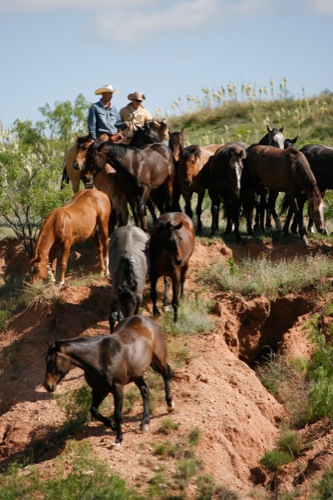
Courtesy River Breaks Ranch
The Old West is alive and kicking in the Lone Star state. Chuck wagons, cowboys and trail rides allow groups to experience the state’s expansive landscapes, and ranching traditions, and lifestyles are preserved so today’s visitor can understand what life was like on the Texas range.
River Breaks Ranch
Amarillo
Groups at River Breaks Ranch climb into a wagon and head out for a 20-minute trail ride that drops down into a private canyon with soaring walls. Along the way, a thunderous cattle stampede passes by, giving passengers a glimpse of what settlers faced as they crossed the vast Texas Panhandle.
At trail’s end, cowboys serve breakfast or dinner in an indoor facility or on a 2,000-square-foot screened porch. Inside, Western art hangs museum-style on the walls. A 4,000-square-foot flagstone patio out back overlooks the canyon. Groups can upgrade and add guitar picking and Western singing as entertainment.
Cooks prepare meals over a mesquite fire chuck wagon-style: Slow-cooked barbecue comes with salad, red beans and homemade biscuits with dutch oven cobbler for dessert. Breakfast consists of dutch oven biscuits, country sausage, eggs and homemade skillet gravy.
Afterward, horse racing revs up the group as members cheer for their favorite steeds. Everyone begins with $70 of Ranch Bucks as betting currency, and participants wager on the results of five races, each featuring four to eight horses. The high money winner receives a trophy. Bucks can be used for discounts on gift shop items.
“Racing is definitely the most popular part of the event,” said Curt Cornett, managing partner at the ranch. “People really love to cheer for their horse, and they study the horses and pick favorites. We’ve had a million-dollar winner out here, all in Ranch Bucks of course.”
Buffalo Gap Historic Village
Abilene
Buffalo Gap Historic Village, part of the Texas Frontier Heritage and Cultural Center, brings historic West Texas to life in a collection of 21 buildings from the state’s frontier era, 1875-1925.
After watching a 10-minute interpretive film that gives an overview of the village, groups take self-guided audio tours that give background and period information about the buildings. An average self-guided tour lasts 45 minutes, but there’s enough content for four hours or more.
“We consider ourselves an outdoor museum,” said Amy Smith, executive director of the Texas Frontier Heritage and Cultural Center. “We can provide an interpretive teacher for the 1920s schoolhouse or a guided tour of the buildings, if set up in advance.”
Hundreds of years ago, great herds of buffalo roamed the area, and it soon became a favored camp for Native American tribes. Eventually, Buffalo Gap became the first county seat of Taylor County.
A two-story, limestone county courthouse with a courtroom and jail was completed in 1879. The county seat moved to Abilene in 1883. Today, the courthouse and jail are part of the village and house an Indian arrowhead and frontier weapons collection.
Other buildings include a log cabin, a barbershop, a bath house, a train depot, a blacksmith shop and the furnished Hill House, once owned by Abilene’s marshal.
The R. Lee and Ann Rode Gallery displays historic maps and artwork by area artists. The center’s Texas History Store is chock full of Texas-related books, gifts and souvenirs.
www.tfhcc.com
National Ranching Heritage Center
Lubbock
Texas’ roots on the range come to life at the National Ranching Heritage Center (NRHC). Bunkhouse and line camp life are re-created with 48 historic structures relocated and restored on more than 16 acres. Many stood on famous ranches, such as the Matador and King ranches, which spearheaded the development of modern ranching.
Showcasing the evolution of ranching from the 1780s to today, buildings include an 1838 trail driver’s one-room cabin, a dugout, a cow-chip house, shipping pens and a coal-burning locomotive.
The Pitchfork Ranch cookhouse, built in the 1890s, was in continuous use until 2007, when it was moved to the center. A prosperous Victorian rancher’s house dates to 1909. Visitors also learn about modern management of the cattle business.
“Those who don’t have a lot of exposure to Western history will have a new appreciation and understanding of what the pioneers and ranchers faced and what modern ranchers still deal with today,” said Jim Pfluger, executive director of the National Ranching Heritage Center and Ranching Heritage Association.
The center recounts ranching history from the slaughter of the buffalo and military conquest of the Plains Indians to the invention of barbed wire and the introduction of the windmill, which transformed the industry.
On Saturdays in spring, summer and fall, costumed interpreters demonstrate activities like quiltmaking, butter churning and branding.
Reopened this fall, the NRHC museum features permanent and temporary exhibits on Western topics. Virtual tours of the park’s historic buildings highlight the background of each ranch represented by the reconstructed buildings.
www.nrhc.ttu.edu










